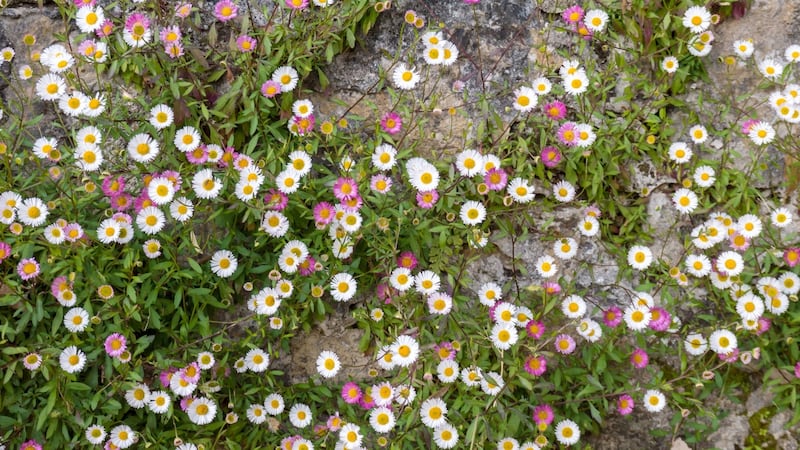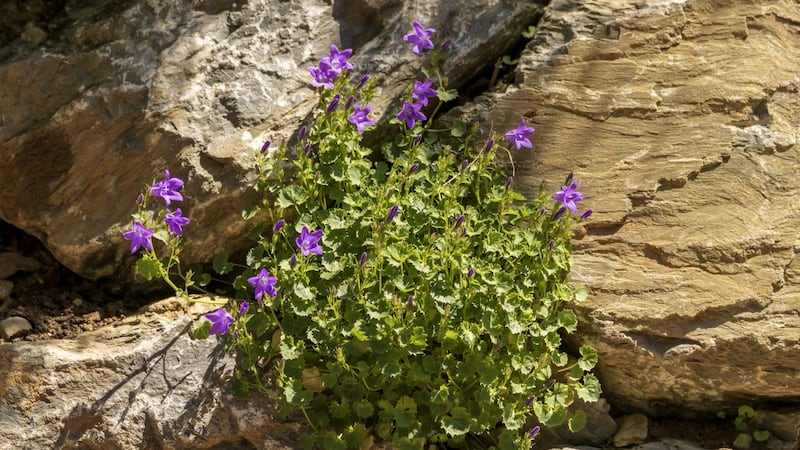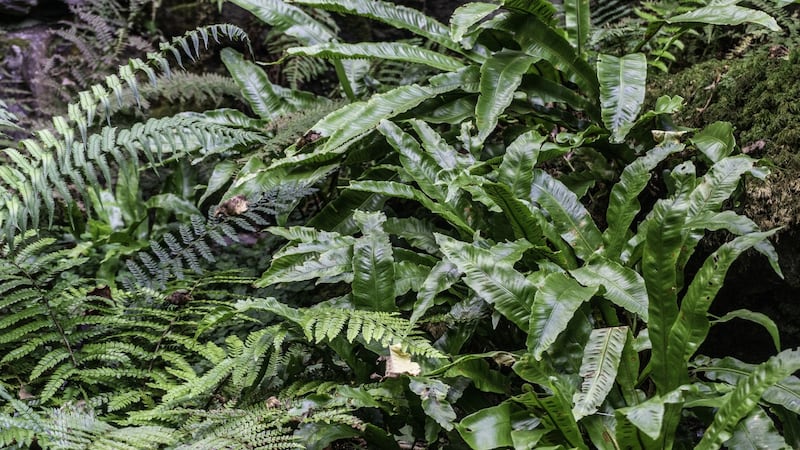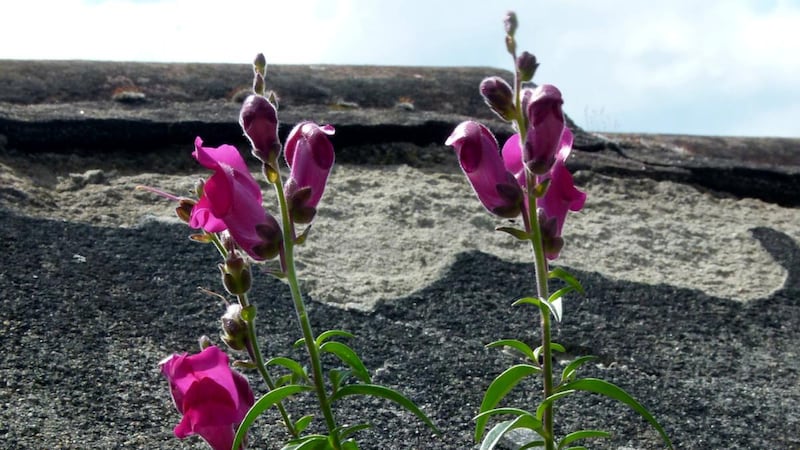Tucked into a matchbox-sized mossy crevice in the base of an old garden wall right next to a busy Dublin city pavement is a fairy world in miniature that I recently spotted from my car window. A Thumbelina-sized portal into a child’s universe with its own tiny, forget-me-not blue fairy doorway framed in minuscule flowers, it’s a sweet and strangely mesmerising reminder of the power we all have to reimagine the most ordinary of spaces.
The very same goes for those plants with the power to dramatically transform what might initially seem to be the most unpromising nooks and crannies of your garden or allotment. By which I mean those tiny niches in sun-baked and shady stone walls, those narrow gaps between paving slabs or – if yours is a rocky garden – the small slivers of space between rocks and stones.
The good news is that a surprising number of species actually like to grow in these unlikely places, all of them sharing a fondness for a very sharply-drained, not overly rich growing medium and with an ability to produce ultra-resilient root systems that thrive in extremely confined spaces.
One of the best-known examples is the sweetly-scented, sun-loving wall flower (Erysimum cheiri), the biennial/short-lived perennial whose common name is due to the fact that it can often be seen as a garden escapee growing on old walls. There’s a majestic castle ruin that I know, not far from Dingle, whose towering, crumbling walls are magically sprinkled with its perfumed, golden-yellow flowers each spring.

Other very common garden escapees also often seen colonising sun-baked old walls, embankments, banks and rock faces include the pretty snapdragon (Antirrhinum majus), with its colourful, bee-friendly summer flower spikes in almost every shade under the sun, and the dainty toadflax (Linaria purpurea), whose slender flower spikes are loved by pollinating insects. The challenging spots these plants so often choose to inhabit – the tiniest cracks and stoniest, sun-parched gaps in city pavements and high walls – is firm proof of their need for sharp drainage and full sun.
Light shade
Yet another toughie is the brilliantly versatile Mexican fleabane (Erigeron karvinskianus), a plant that should be in every garden. A compact, clump-forming, drought-tolerant semi-evergreen perennial that grows best in full sun, it will also tolerate light shade. Covered in a mass of tiny, daisy-like white-pink blooms from late spring to autumn, Mexican fleabane will gently self-seed into small cracks and chinks in walls or between paving slabs, creating a pretty, delicate froth of flowers and foliage that gently blurs and softens the edges of hard landscaping in a way that’s always welcome.

The hardy alpines known as the New Zealand burr (Acaena microphylla and Acaena buchananii) are two other plants with a very lovely way of elegantly draping themselves over the hard edges of walls, stones and paving slabs. Ultra-low growing, mat-forming perennials that grow happily in sun or light shade, their small flowers emerge in summer but it's their evergreen, finely cut, grey-blue pinnate foliage (in the case of A microphylla, its young foliage is flushed with bronze) that makes them both stand-out plants.
Many other types of low-growing alpines and herbs will similarly thrive in these kinds of challenging growing conditions, which echo their habitats in the wild. Examples include creeping species of perennial phlox (varieties of Phlox subulata); fleshy, sun-loving stonecrops (the hardy, summer-flowering Sedum sexangulare, Sedum spurium, Sedum acre, Sedum album); creeping thyme (Thymus pulegioides); mountain rock cress (Arabis alpine ssp. caucasica); perennial candytuft (Iberis sempervirens) chamomile (Chamaemelum nobile); and aubrietia.

Other plants that will grow in similarly free-draining but shadier, cooler nooks and crannies in the garden or allotment include some of the compact, clump-forming/trailing species of bellflower such as the pretty Campanula poscharskyana, Campanula cochlearifolia and Campanula portenschlagiana. So will some species of mint including pennyroyal mint (Mentha pulegium), saxifrages and different species of spleenworts such as the lovely evergreen native hart’s tongue fern, Asplenium/Phyllitis scolopendrium and Asplenium trichomanes.

Soft carpets
Many of the above plants form soft carpets, clumps or mats of flowers and/or often aromatic foliage that can be used to artfully soften the hard landscaping elements of a garden by allowing them to gently tumble over the edges of walls and raised beds, planting them into gaps in dry stone walls or where they’ll form low, leafy pools between paving cracks. As a rule all are best planted as young plugs or small divisions with compact root systems that are easier to tuck into small spaces (large plants with big root-balls are inevitably very difficult to accommodate in these tricky kinds of spots). Just make sure to keep them watered until they establish.

Given time, many will also pleasantly surprise you by self-seeding, often politely inveigling themselves into those inaccessible little crannies of the garden where conventionally planted specimens would struggle to establish viable root systems. You can help them along by filling any small gaps, cracks and crevices in or along the tops of walls and between paving slabs with some gritty compost (use a 50:50 mix of compost and sharp sand/horticultural grit) and by allowing established plants to self-seed rather than deadheading them.
In really tricky areas where the growing space is so tiny that it’s impossible to plant into it, simply position pot-grown parent plants where you’d like them to self-seed and then keep a careful eye out for any baby seedlings that emerge so you don’t accidentally weed them out or hoe them away. Be patient and you’ll be both amazed and delighted by where they’ll eventually pop up.
This Week in the Garden

Dahlias are some of the showiest stars of the late summer garden but need regular care to perform at their very best. For optimum results, keep them well-watered, properly staked, regularly deadheaded, protected from slugs and give established plants a potash-rich liquid feed every seven to 14 days.
Very hot weather like that of recent days can quickly cause plant stress resulting in reduced growth, poor flowering and poor fruiting unless they are kept well-watered. For best results, water plants in the evening to allow time for it to properly soak through to their root systems, making sure to water generously but gently around the base of each plant. For the same reason, make sure to keep glasshouses and polytunnels very well ventilated and irrigated and regularly damp down surfaces to help keep temperatures from rising dangerously high. Placing a few large containers of water in polytunnels or glasshouses will also help to regulate the temperature while soil mulches and liquid seaweed feeds are also very beneficial.
Dates for Your Diary
On Sunday, July 25th (11am-5pm), Mount Congreve Gardens, Kilmeaden, Co Waterford, plant fair with many of Ireland's specialist plant nurseries offering rare and choice plants for sale, plus plant creche and local food stalls. Admission €7 (seniors €6) includes entrance to the 70-acre garden, see mountcongreve.com
From Saturday, July 24th to Sunday, August 1st, Carlow Garden Festival 2021 with a wide range of expert speakers including well-known garden designers Paul Martin, Arthur Shackleton, Patricia Tyrrell and Diarmuid Gavin, plantspeople Mary Keenan, Thomas Pakenham, Seamus O'Brien, Paul Smyth and Paul Maher, organic seed producer Madeline McKeever, wildlife expert and environmentalist Éanna Ní Lamhna, kitchen gardener Klaus Laitenberger, garden writer Shirley Lanigan and horticultural therapist and designer Fiann Ó Nualláin, see carlowgardentrail.com or call 059 9130411

















